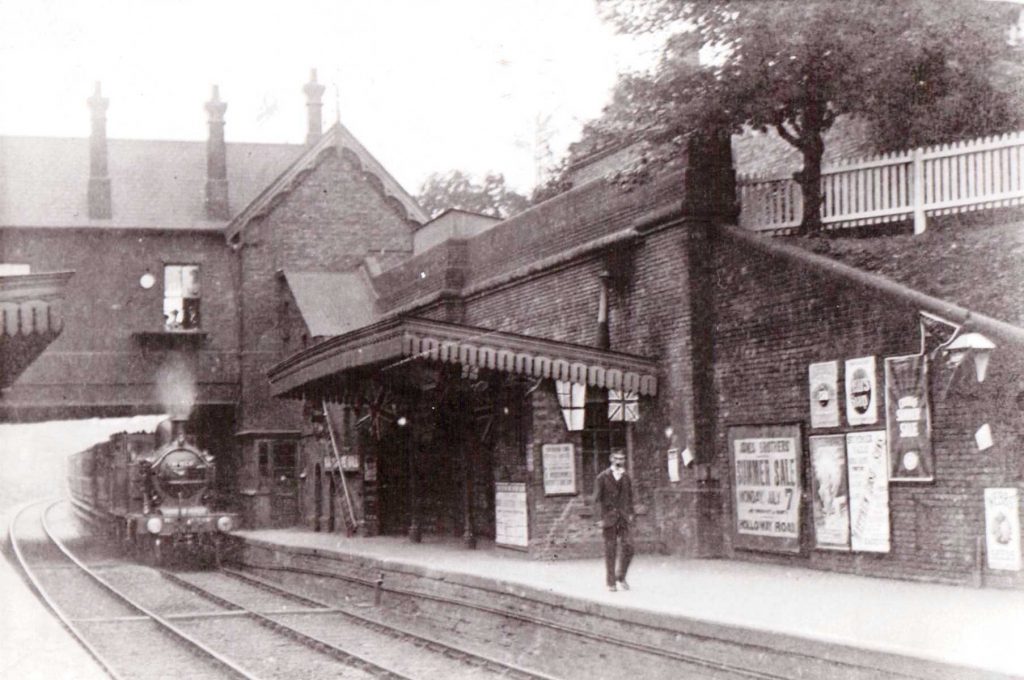
Historian David Cockle, from The Enfield Society, takes a look back at the fascinating history of the Hertford Loop railway line
Great Northern Railway (GNR) opened its new branch line from Wood Green to Enfield on 1st April 1871, just over 150 years ago.
This was a modification to the act of parliament, passed in March 1865, for a new railway from Hornsey to Hertford. GNR wanted an alternative route to provide relief to the busy section of its main line south of Hitchin.
The plan was to join up the Hatfield to Hertford (Cowbridge) branch, just south of Hertford. Trains would then head west to join the Great Northern Main Line south of Digswell Viaduct, by means of a new north-facing curve.
However, a financial crisis in 1866 caused the Hornsey to Hertford line beyond Enfield to be abandoned, making Enfield the terminus of the new route. There were initially just two intermediate stations on the branch line; Palmers Green and Winchmore Hill. Bowes Park opened later, on 1st April 1880.
The branch had to cross the valleys of the Pymmes and Salmons brooks, which led to some high embankments. Where the line crossed Salmons Brook, at Grange Park, was particularly troublesome, with the heavy clay soil causing slips. The Board of Trade sanctioned the new branch on condition that a 10mph speed restriction be imposed over the embankment. Additionally, a watchman was stationed at the line side, in case of any further slips.
There were initially 16 weekday trains and five on Sundays, nearly all running to Moorgate Street via Farringdon Street (both stations are now sans ‘street’). One mid-morning train actually ran through to Victoria via Ludgate Hill and Brixton. The frequency gradually increased with North London Railway running trains from Broad Street to Enfield in 1875 and South Eastern Railway running trains through from Woolwich in 1879.
It was not until the late 1880s that suburban development arrived around Bowes Park, by which time the train service had increased to nearly 30 a day. Palmers Green and Winchmore Hill, meanwhile, remained rural in character until the 1900s, when estate land became developed.

Suburban traffic steadily increased, but competition arrived in 1907, with the electric trams running from Finsbury Park along Green Lanes to reach Palmers Green (1907), Winchmore Hill (1908) and Enfield (1909). This caused both relief and concern for the GNR; serious peak-hour congestion at Kings Cross was relieved, but some off-peak traffic was lost. Competition from the tube also led to the withdrawal of the cross-London trains to Victoria and Woolwich in 1907.
A significant development had come in 1898 when the new Enfield to Stevenage line was approved. This would provide the long-awaited alternative route to relieve the main line. But it took considerable time to arrange the finance and contracts and it was not until January 1906 that the first contract was let for a four-and-a-half mile section out to Cuffley.
The extension started at Grange Park, in order for the line to gain height and cross Windmill Hill via a new bridge. Two viaducts were also built, one north of Gordon Hill (Rendlesham), to carry the line over Turkey Brook, and one south of Cuffley (Soper’s Farm) to cross Northaw Brook.
The old Enfield terminus was converted into a goods depot, while a new station (today’s Enfield Chase) was built adjacent to the new bridge over Windmill Hill.
On 4th April 1910, the Cuffley extension was opened with its new stations; Grange Park, Enfield, Gordon Hill, Crews Hill and Cuffley. The majority of trains turned back at Gordon Hill, with 16 going through to Cuffley. As Crews Hill and Cuffley had little housing, the demand for travel was low.

The First World War delayed completion of the next extension, from Cuffley to Stevenage. It involved boring two tunnels, Ponsbourne and Molewood. Two viaducts south of Hertford were built to carry the line over the rivers Lea and Mimram. Eventually, on 4th March 1918, a single line opened for freight trains providing the desired link through to the main line – and the ‘Hertford Loop’ was born.
By December 1920, the track was doubled, and on 2nd June 1924 new stations opened at Bayford, Hertford North, Stapleford and Watton-at-Stone.
Most stations had goods yards handling domestic coal and general merchandise. The Palmers Green yard was extended in 1928, with two new sidings serving a loading wharf for building material on the west side of the line.
Winchmore Hill sidings lay between Vicars Moor Lane and Green Dragon Lane and, up to the early 1950s, there was an early-morning milk train from Kings Cross, loaded with churns for Nix Dairy. But the busiest yard was at the old Enfield terminus; among the goods it handled were bananas for Fyffes, which set up a banana ripening plant there.
As late as 1962, a coal concentration depot was established at Enfield, receiving fuel direct from collieries. This was short-lived, as in 1974 the Enfield sidings were closed and the land sold for housing.
In the early days of the Hertford Loop, trains consisting of up to eleven gas-lit coaches were pulled by small tank locomotives. There were first, second and third class compartments. Improvements came in 1925 when new, smooth-riding ‘Quadart’ coaches with articulated bogies were introduced. These were hauled by new powerful Class N2 tank locomotives, which had seats for 600 passengers and ran for almost 40 years.
In 1958, diesel trains replaced some steam trains and, in summer 1959, all passenger trains were scheduled as diesel trains, heralding the end of steam on the route. In 1976, the line was electrified, and trains started taking a new shorter route to Moorgate via Highbury & Islington.
The latest improvement came in 2019, when the first-generation electric trains were replaced by new Class 717 trains, and the best-ever timetable saw 180 trains scheduled each weekday.
During the pandemic, passenger numbers plummeted to 15%, but this is now increasing steadily. It remains to be seen whether the number of commuters travelling to the City reaches pre-Covid levels, but the trend shows leisure travel increasing faster.
The Hertford Loop is now assured a bright future, both as a diversion from the main line, and in serving North London’s suburbs and Hertfordshire.
 No news is bad news
No news is bad news
Independent news outlets like ours – reporting for the community without rich backers – are under threat of closure, turning British towns into news deserts.
The audiences they serve know less, understand less, and can do less.
If our coverage has helped you understand our community a little bit better, please consider supporting us with a monthly, yearly or one-off donation.
Choose the news. Don’t lose the news.
Monthly direct debit
Annual direct debit
£5 per month supporters get a digital copy of each month’s paper before anyone else, £10 per month supporters get a digital copy of each month’s paper before anyone else and a print copy posted to them each month. £50 annual supporters get a digital copy of each month's paper before anyone else.
More information on supporting us monthly or yearly
More Information about donations









 Enjoying Enfield Dispatch? You can help support our not-for-profit newspaper and website from £5 per month.
Enjoying Enfield Dispatch? You can help support our not-for-profit newspaper and website from £5 per month.